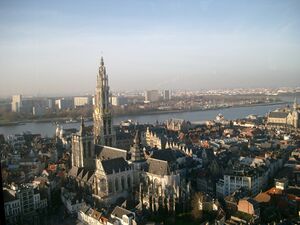Antwerp
(City) | |
|---|---|
 | |
| Subpage(s) | •Antwerp/Governor |
| Large port and oil refinery city, world center for the diamond trade. | |
Antwerp (Dutch: Antwerpen/French: Anvers) is a city in Belgium and the capital of Antwerp province in the Flemish Region. With a population of 520,504,[1] it is the most populous city in Belgium, and with a metropolitan population of around 1,200,000 people, it is the second-largest metropolitan region after Brussels.
Antwerp is on the River Scheldt, linked to the North Sea by the river's Westerschelde estuary. It is about 40 kilometres (25 mi) north of Brussels, and about 15 kilometres (9 mi) south of the Dutch border. The Port of Antwerp is one of the biggest in the world, ranking second in Europe[2] and within the top 20 globally. The city is also known as the world capital in the diamond industry.
Economy
Port
The port of Antwerp was the seventeenth largest (by tonnage) port in the world in 2005 and second only to Rotterdam in Europe. It handled 235.2 million tons of cargo in 2018. Importantly it handles high volumes of economically attractive general and project cargo, as well as bulk cargo. Antwerp's docklands, with five oil refineries, are home to a massive concentration of petrochemical industries, second only to the petrochemical cluster in Houston, Texas. Electricity generation is also an important activity, with four nuclear power plants at Doel, a conventional power station in Kallo, as well as several smaller combined cycle plants. There is a wind farm in the northern part of the port area. There are plans to extend this in the period 2014–2020.[3]
Diamonds
Antwerp's other great mainstay is the diamond trade that takes place largely within the diamond district.[4] 85 percent of the world's rough diamonds pass through the district annually,[5] and in 2011 turnover in the industry was $56 billion.[6]
Antwerp's history in the diamond trade dates back to as early as the sixteenth century,< with the first diamond cutters guild being introduced in 1584. The industry never disappeared from Antwerp, and even experienced a second boom in the early twentieth century. By the year 1924, Antwerp had over 13,000 diamond finishers. Since World War II families of the large Hasidic Jewish community have dominated Antwerp's diamond trading industry, although the last two decades have seen Indian[7] and Maronite Christians from Lebanon and Armenian,[8] traders become increasingly important.
Antwerp World Diamond Centre, (AWDC) the successor to the Hoge Raad voor Diamant, plays an important role in setting standards, regulating professional ethics, training and promoting the interests of Antwerp as the capital of the diamond industry.
However, in recent years Antwerp has seen a downturn in the diamond business, with the industry shifting to cheaper labor markets such as Dubai or India.[9]
Minorities
In 2010, 36% to 39% of the inhabitants of Antwerp had a migrant background. A study projects that in 2020, 55% of the population will be of migrant background.[10][11]
Group
| Group | Start | Description |
|---|---|---|
| University of Antwerp | 2003 | Major Belgian university located in the city of Antwerp |
References
- ↑ http://statbel.fgov.be/nl/modules/publications/statistiques/bevolking/bevolking_-_cijfers_bevolking_2010_-_2012.jsp
- ↑ http://www.portofantwerp.com/sites/portofantwerp/files/Annual%20Report%202014_EN.pdf Page 14
- ↑ https://web.archive.org/web/20140430023952/http://www.sustainableportofantwerp.com/en/content/people/wind-farm
- ↑ https://www.nytimes.com/2012/11/06/world/europe/antwerps-diamond-industry-tries-to-keep-its-luster.html
- ↑ https://businessinantwerp.eu/sectors/diamond
- ↑ https://www.post-gazette.com/news/world/2012/11/06/An-Industry-Struggles-to-Keep-Its-Luster/stories/201211060199
- ↑ http://www.stefangeens.com/wsj.html
- ↑ https://www.theguardian.com/world/2009/jun/23/diamond-gems-trade-antwerp-belgium
- ↑ https://www.nytimes.com/2006/01/01/world/europe/twilight-in-diamond-land-antwerps-loss-indias-gain.html
- ↑ {http://www.nieuwsblad.be/article/detail.aspx?articleid=GEL2M0RO6
- ↑ https://nl.express.live/antwerpen-in-2020-voor-55-allochtoon-exp-126467/